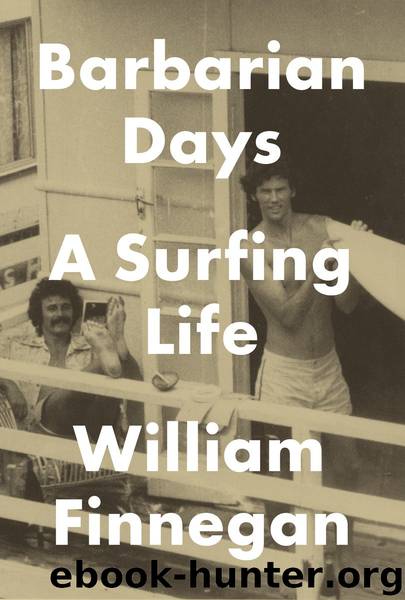Barbarian Days by William Finnegan

Author:William Finnegan
Language: eng
Format: epub
Publisher: Penguin Publishing Group
Published: 2015-06-23T16:00:00+00:00
Bryan, me, and José from Ecuador, Grajagan, Java, 1979
SEVEN
CHOOSING ETHIOPIA
Asia, Africa, 1979–81
BRYAN LOATHED BALI. HE WROTE AN ARTICLE FOR TRACKS—IT carried, by tradition, both our names, though I only gave it a light edit—mocking the notion, then widespread among Australian surfers, that Bali was still an unspoiled paradise of uncrowded waves and mellow Hindu natives. In fact, he wrote, it was overrun with surfers and other tourists. It was a place where one could “see topless and bottomless Europeans of both sexes,” “listen to the lies of surfers from all over the world,” “hire a board carrier and experience the dizzying thrill of colonialism,” and “tell people you’re from Cronulla when you’re really from Parramatta,” the latter being a less cool Sydney suburb than the former.
I agreed that Bali was overrun, and the collision of mass tourism and Indonesian poverty was grotesque, but the place suited me nonetheless. We stayed in a cheap, clean losmen (guesthouse) in Kuta Beach, ate well for practically nothing, and surfed daily. I found a good writing spot in a college library in Denpasar, the provincial capital, catching a bus there each morning. It was a cool, quiet refuge on a hot, noisy island. My novel was rocking along. A street vendor with a little turquoise cart would show up outside the library at midday, my signal to knock off. He served rice, soup, sweets, and satay through the opened windows of campus offices. I liked his nasi goreng—fried rice. In the afternoons, if there was swell, Bryan and I headed out the Bukit Peninsula, where a brace of great lefts broke off limestone cliffs. There were good waves around Kuta too, even on small swells, and, when the wind blew southwest, in a resort area on the east coast, Sanur.
The spot that sank its hooks in me the deepest was a sweeping, already famous left called Uluwatu. It was out on the southwestern tip of the Bukit. There was an eleventh-century Hindu temple, built of hard gray coral, perched on the edge of a high cliff just to the east of the wave. You entered the water, at high tide, through a sloshing sea cave. Uluwatu got big, and on bigger days, when the wind was light offshore, the long blue walls did something I had never seen elsewhere. In discrete, well-separated places along the swell line, they gently feathered far, far ahead of where you were surfing—hundreds of yards ahead, and hundreds of yards from shore. There were apparently a series of narrow rock ridges running out to sea from the inside reef, formations shallow enough to make a big wave feather but not, at least on the swells we surfed, to make it break. It was unsettling at first, but then, after a few screaming rides on massive waves that did not close out, the sight of those distant feathering sections just heightened the joy of rocketing around in the breaking part of the wave, since those strange wafts of spray out in the bay would soon become, you came to trust, solid sections on the inside shelf.
Download
This site does not store any files on its server. We only index and link to content provided by other sites. Please contact the content providers to delete copyright contents if any and email us, we'll remove relevant links or contents immediately.
Breath by James Nestor;(2163)
The River by Peter Heller(2152)
Deep by James Nestor(2087)
Fatal Storm by Rob Mundle(2084)
Sea Survival Handbook by Keith Colwell(2045)
Lonely Planet Australia by Lonely Planet(1974)
Iced In by Chris Turney(1853)
Discover Australia by Lonely Planet(1845)
Lonely Planet Maldives (Travel Guide) by Planet Lonely & Masters Tom(1736)
One Girl One Dream by Dekker Laura(1581)
Looking for a Ship by John McPhee(1577)
Ten Degrees of Reckoning: The True Story of a Family's Love and the Will to Survive by Hester Rumberg(1554)
Chicken Soup for the Ocean Lover's Soul by Jack Canfield(1553)
Lonely Planet Australia (Travel Guide) by Lonely Planet & Lonely Planet(1512)
South with the Sun by Lynne Cox(1463)
The Wave In Pursuit of the Rogues, Freaks and Giants of the Ocean(1431)
Diver Down by Michael Ange(1422)
Marlinspike Sailor's Arts and Crafts by Barbara Merry(1412)
The Golden Rules: 10 Steps to World-Class Excellence in Your Life and Work by Bob Bowman & Charles Butler(1385)
